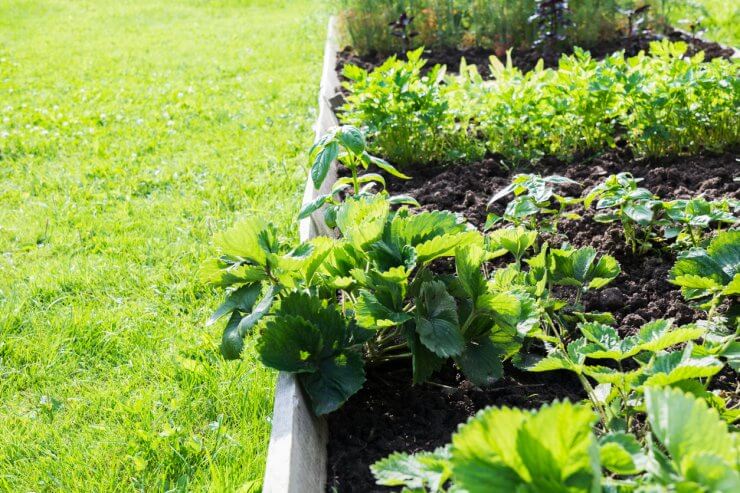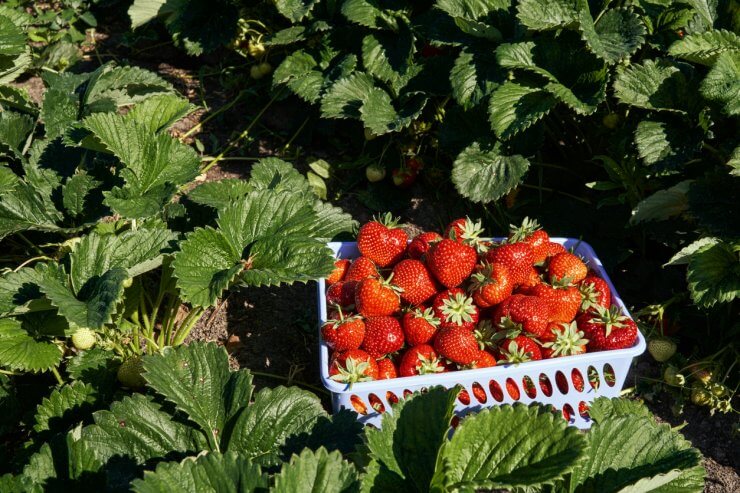
Strawberries in open ground
You have plenty of choices for growing strawberries, depending on preference and availability of garden space. For those with limited space, it’s easy to grow strawberries in hanging baskets, though in order to get more than a token harvest you’ll need to have several baskets.
Alternately, you can get a lot of strawberry plants in the grow bags that are sold at nurseries. They have pockets made for strawberry plants and you can grow a lot of plants in a small space.
The advantages to growing strawberries in hanging containers include helping your plants drain properly—and drainage is crucial to avoiding root rot—and also keeping your plants out of reach of deer and rabbits that might want to feast on your berries.
You can also grow strawberries in pots, with the option again of a container that has pockets for holding multiple plants. As with hanging pots, you get to enjoy the pretty flowers as well as the fruit when it arrives! And you can move potted strawberries to make sure they get optimum sunlight.
Consider adding a watering tube to your potted strawberries to ensure that the water gets all the way down into the roots. If you can’t buy one, try drilling holes into a PVC pipe and filling it with sand to slow the release of water.
Consider using a premium bagged potting mix for your container strawberries to maximize plant health and yield.
Raised beds and open ground

Strawberries in raised bed
A raised garden bed or planter is an excellent option for growing strawberries. These also help with all-important drainage. Consider building a pyramid-style bed with raised steps that allows you to get a lot of strawberry plants into a small space. You can even buy raised beds or build one yourself to fit your space.
Watering, weeding, and even harvesting are much easier with raised beds, with items closer to your reach and contained in a space that is more manageable than growing in open land. What’s more, filling a raised bed with packaged garden soil means a cleaner and healthier environment for your plants.
That means less weeding, which is itself easier because you don’t have to bend down as far to get to the invaders!
That said, strawberries love growing in open ground, too, where they have plenty of room to spread out their runners. And it’s not just the food garden where you’re obliged to grow strawberries: Consider using them as a pretty, edible edging plant at the front of a perennial border or along a driveway or sidewalk (day-neutral types are best for this because of their lack of runners) or let them spill over a garden wall or fence.
Plant in rows or a grid

Row of strawberry plants
Planting large numbers of strawberries in rows makes it easier to control weeds, pests, and runners. The most common practice is spacing plants 18 to 24 inches apart in rows that are 3 to 4 feet apart. This keeps plants with runners from becoming overcrowded.
If growing strawberries as a ground cover, plant the mother plants in a grid, either 1 x 1 foot or 2 x 2 feet. This kind of planting will require regular weeding, especially in the first year, but maintenance will be minimal once plants are established.
After planting, firm the soil around each plant and water thoroughly.
Tip: When you notice a drop in productivity after two to five years, you’ll want to replace your strawberry plants with new ones. Buy new starters instead of digging up runners from an old patch, to guarantee healthy, disease-free plants. Also, choose a new site for your replacements to avoid pests and diseases that may have accumulated in the soil over the years.
How do you grow your strawberries—in open land, in raised beds, or in containers? Why do you prefer your method? Please tell us your tips and tricks for creating an awesome strawberry patch.


 Previous
Previous


which is better to use as mulch (cleaner ?) for strawberries in a raised bed Pine straw, cedar chips or shreds? chopped leaves